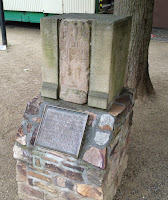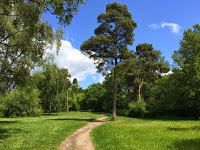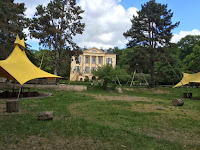 The village just west of Wiesbaden probably got its name (and crest, a “T”) owing to a count of the court of King Dagobert I called Tuzzo, but the designation Dotzheim was to become an important aristocratic line under the rule of the House of Nassau in its own right and the cast-iron mascots, Dotzi, hung on many of the older buildings at the town centre.
The village just west of Wiesbaden probably got its name (and crest, a “T”) owing to a count of the court of King Dagobert I called Tuzzo, but the designation Dotzheim was to become an important aristocratic line under the rule of the House of Nassau in its own right and the cast-iron mascots, Dotzi, hung on many of the older buildings at the town centre.
 A bit further on (which is why I needed to split up my walk—plus it started to rain) one encounters Schloss Freudenberg—which, for being only built in the early 1900s, has a pretty extensive and complex history. It was completed in 1903 but the youngest castle in Germany dates from 1908, and is included in this collection. The mansion was commissioned by a Scottish post-impressionist painter and his wife but they only lived there a few years—to be later appropriated as a home for expectant mothers and young children of the Lebensborn programme.
A bit further on (which is why I needed to split up my walk—plus it started to rain) one encounters Schloss Freudenberg—which, for being only built in the early 1900s, has a pretty extensive and complex history. It was completed in 1903 but the youngest castle in Germany dates from 1908, and is included in this collection. The mansion was commissioned by a Scottish post-impressionist painter and his wife but they only lived there a few years—to be later appropriated as a home for expectant mothers and young children of the Lebensborn programme. During the course of the war, a garrison was built up on the surrounding gardens near this railhead and was afterwards occupied by the US forces. Freudenberg became an officers’ club and casino until 1973 when it abandoned and fell in disrepair.
During the course of the war, a garrison was built up on the surrounding gardens near this railhead and was afterwards occupied by the US forces. Freudenberg became an officers’ club and casino until 1973 when it abandoned and fell in disrepair. The castle was saved from ruin by a group of adherents to the philosophy of Hugo Kükelhaus, who turned the estate into playground for the senses. Kükelhaus along with his promoted exercising ones perceptions to the fullest in order to hone ones imagination and understanding of the world and eschewed the sanitary, inhuman architecture and design that confined and exhausts by removing those things we are made to feel.
The castle was saved from ruin by a group of adherents to the philosophy of Hugo Kükelhaus, who turned the estate into playground for the senses. Kükelhaus along with his promoted exercising ones perceptions to the fullest in order to hone ones imagination and understanding of the world and eschewed the sanitary, inhuman architecture and design that confined and exhausts by removing those things we are made to feel. Several permanent installations, called experience stations (Erfahrungsfelder), are on display.
 The ongoing renovation project itself is also an extension of Kükelhaus’ beliefs and is therapeutically defined as the combination of healing and art. There is the further objective of educating visitors in abstractions that are independent of the powers of perception (by cultivating and refining one’s physical senses as much as possible) so that they might apprehend what’s just beyond—like dignity and equality.
The ongoing renovation project itself is also an extension of Kükelhaus’ beliefs and is therapeutically defined as the combination of healing and art. There is the further objective of educating visitors in abstractions that are independent of the powers of perception (by cultivating and refining one’s physical senses as much as possible) so that they might apprehend what’s just beyond—like dignity and equality.As well as being the home and headquarters of Hugo Kükelhaus’ movement, Schloss Freundenberg hosts regular seminars and events for kindred organisations and schools of thought. By rushing through I suppose that I was completely missing the point by not playing and discovering fully, but when there is more time, I certainly plan to return and experience all the textures and trapezes.























